Games of 2018
I don’t think 2018 was quite as good a year for games as last year was (there was nothing that blew me away the way Breath of the Wild did), but there were still quite a few good games. I played close to 30 games that came out this year, and narrowing this list down took a bit of work. I’m definitely leaving some good games out of here. I know most of these kinds of lists go in multiples of 5 or 10, but there were 11 games that I wanted to talk about, so that’s how long this list is.
We’ve hit a point where there are far more good games released each year than anyone could reasonably be expected to play. I still haven’t had time to dive into Return of the Obra Dinn, the latest game from Lucas Pope, who previously made one of my favourite games of the past decade – Papers, Please. I recently started Assassin’s Creed Odyssey but I haven’t played enough to form many opinions. I bought God of War during a recent Playstation Network holiday sale, and everyone says it’s great, but I haven’t had time for that yet either. The Red Strings Club sounds like it could be really interesting. I’ve heard lots of good things about Star Traders: Frontiers. I’m intrigued by what I’ve heard of Vampyr. There just isn’t enough time. So I make no claim to this being any definitive kind of list. It’s just a bunch of games I enjoyed playing, and maybe you’ll like them too.
11. Dragon Quest XI
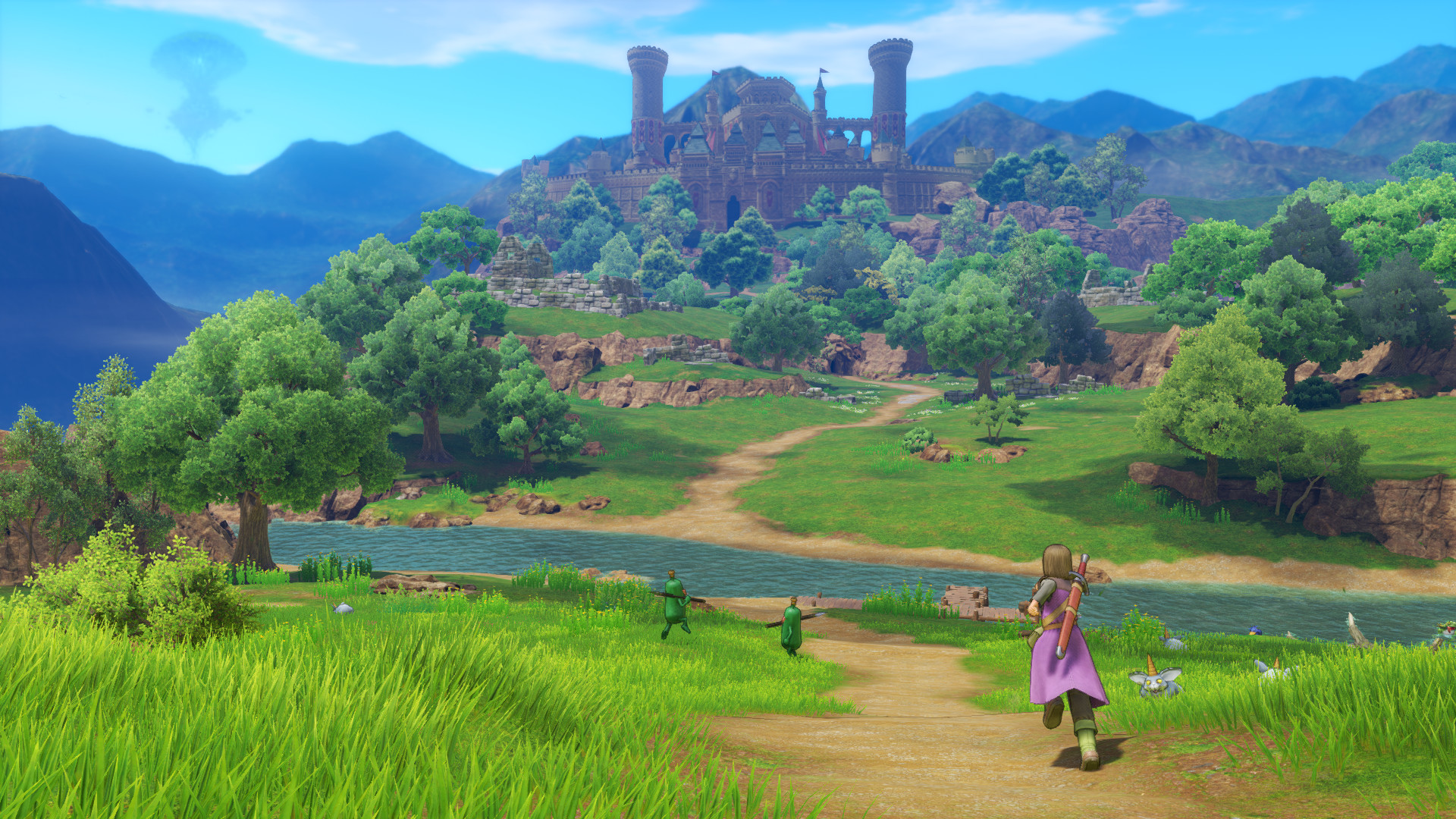
Dragon Quest XI is very much a throw-back JRPG. It has turn-based battles where the player controls a party of four different characters with roles like healer, mage, and warrior, each with their own sets of pre-determined abilities (with a bit of latitude for players to choose as they level up). The story is about a band of plucky adventurers travelling across the globe, going from city to city in an effort to stop an evil force that threatens the entire world. It’s the kind of game that mostly doesn’t get made any more, but it’s very much my kind of game. There’s a lot that I like about Dragon Quest XI, but I have to give special mention to the enemy animations, which are unique, full of character, and often pretty funny. They’ve also done a lot to sand away some of the annoying edges of many JRPGs; for example, the game regularly auto-saves, so you’re never going to lose a huge chunk of progress if your party falls in battle. Mostly it’s a very good game.
It does have a couple of things holding it towards the back of my list, however. One is that it’s a very easy game. There’s not a lot of strategy required to win, even in boss fights. But the bigger issue is that, like most modern role-playing games, it’s just too long. I’ve played it for about 35 hours, and I gather that I’m only a bit over half-way through the game. How Long To Beat has the game taking between 55 and 80 hours to finish, and there just isn’t enough here to justify that length. It could easily be half as long just by cutting down on the amount of grinding, and the player wouldn’t miss anything in the process.
10. Northgard

I’d heard good things about Northgard for a while before I got around to actually playing it. I knew it was a real-time strategy game, but I thought it was heavily combat-focused in the vein of something like Warcraft. It turns out that’s not the case at all. It’s much closer to a 4X game that plays out in real time. The most pressing concern in Northgard is balancing food and lumber, not troop composition. Food is necessary, obviously, to support your growing population, while lumber is used for building structures and for heat. The latter is especially important because of the game’s defining feature, which is that once every in-game year, winter rolls around, and during winter you need far more heat and grow far less food. Because of that, you have to make sure you’re building and storing surpluses during the good months. You’ll often find yourself re-allocating workers during the winter months just to make sure your people don’t freeze or starve.
That’s the core challenge of the game, but there’s much more than that to do, as you have to balance your financial economy, gather knowledge, explore new territories, and defend yourself from attacks. In a major break from most real-time strategy games, most of the combat in Northgard is against small bands of NPCs that you need to clear out to take over new territory, although larger skirmishes against other factions are certainly possible.
On the whole Northgard turned out to be a game about growing your civilization while managing resources. It’s much closer to a Euro boardgame (think Agricola or Puerto Rico) than Warcraft. And so I found myself unexpectedly quite taken with Northgard.
9. Battletech
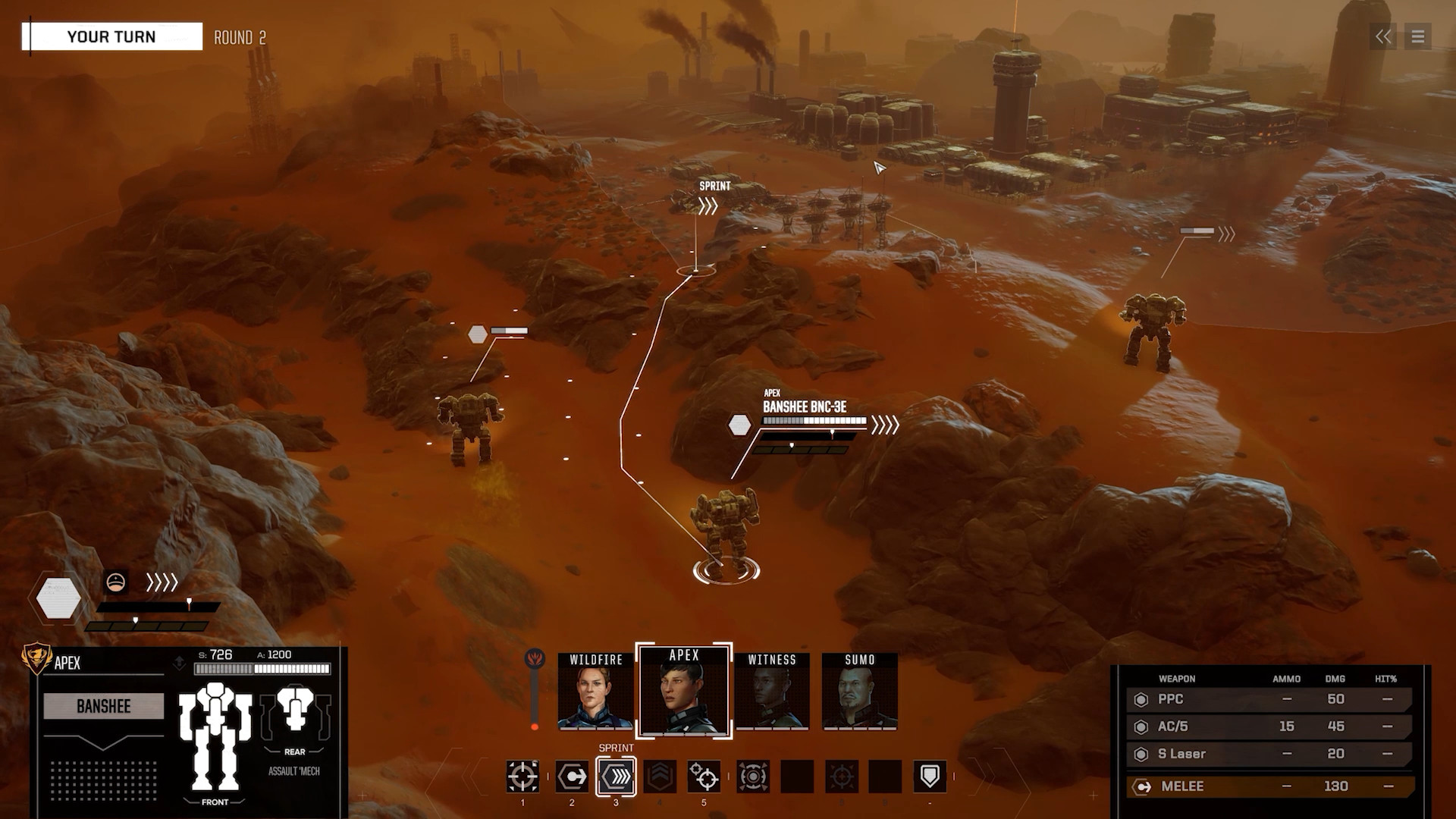
As anyone who’s read my game of the year lists from other recent years would likely know, I’ve been a big fan of the recent Shadowrun computer games. So when I found out that the studio that made them was working on a moderning-up of one of their other old tabletop games, Battletech, I was pretty excited. Mechs just aren’t my thing in the way that cyberpunk is, so I didn’t like Battletech as much as Shadowrun, but it’s still a game I had fun with. Like Shadowrun, Battletech is a turn-based tactics game that draws pretty liberally from the more recent XCom games, melding a lot of XCom‘s user interface design with the old Battletech tabletop game. Tactical RPGs are among my favourite kind of games, so it’s no surprise that I liked this one. It’s a lot of fun to engage in battles of attrition with these giant robots blasting rockets at each other and slugging it out.
Unfortunately, I didn’t put a huge amount of time into this one. I spend all day at work sitting at a computer desk, so when I come home from work I usually don’t want to dump dozens of hours into a game that will require me to sit in front of the computer even more. Still, this one was fun and I hope I can find some time to go back and give it more of an opportunity.
8. Ni No Kuni 2
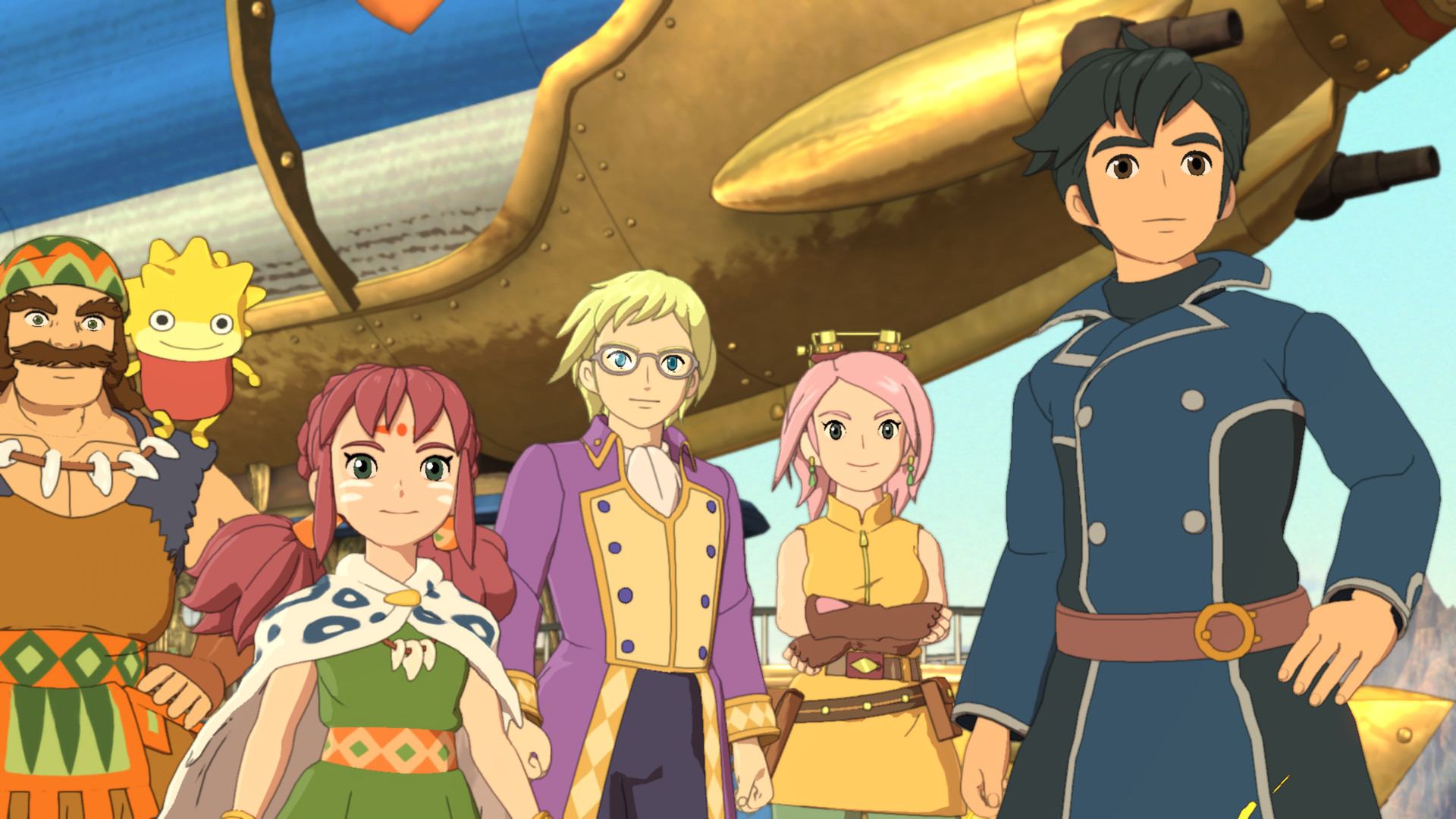
I’m a really big fan of the first Ni No Kuni, a game that combined the art of Studio Ghibli with the design sensibilities of older turn-based JRPGs. The sequel is, unfortunately, not quite as good. It’s lost a lot of what made the original so charming, like it’s melancholy story about a boy learning to cope with his mother’s unexpected death. The first Ni No Kuni also had a neat and somewhat novel mechanic where the player had to travel between the “real” world that we’re familiar with and the fantastical world where most of the game takes place. In the first game it was implied, although never stated outright, that the fantasy world was actually a game in the main character’s imagination that he was playing to try to come to grips with losing his mother. The sequel all but abandons the connection between the two worlds, but it keeps a lot of the other things that worked in the first game.
The art, as you can likely tell from the screenshot above, is gorgeous. The whole game looks like it was painted for a Studio Ghibli movie. The characters are unique and expressive and frequently quite charming. The story itself is fairly simplistic, but it’s also very kind-hearted in a way that I really appreciated. While there is a central villain to be defeated eventually, the bulk of the game is spent as protaganist Evan attempts to build up his kingdom by forming alliances with all of the various kingdoms across the globe, which he does primarily by helping people overcome their problems. There’s a moderately complicated town management layer where the player builds and invests in buildings in their castle town, staffs them with characters who have relevant skills, and tries to improve their kingdom to better face the challenges ahead.
The combat has a lot in common with the Tales RPGs, moving briskly as the player controls one character while the AI handles the rest of the party. It’s a pretty easy game on the whole, but it moves at a brisk pace that kept me engaged. I think my play time upon finishing the final dungeon was something like 35 hours, and I appreciated playing an RPG that respected my time by moving through its story and then finishing up.
7. Into the Breach
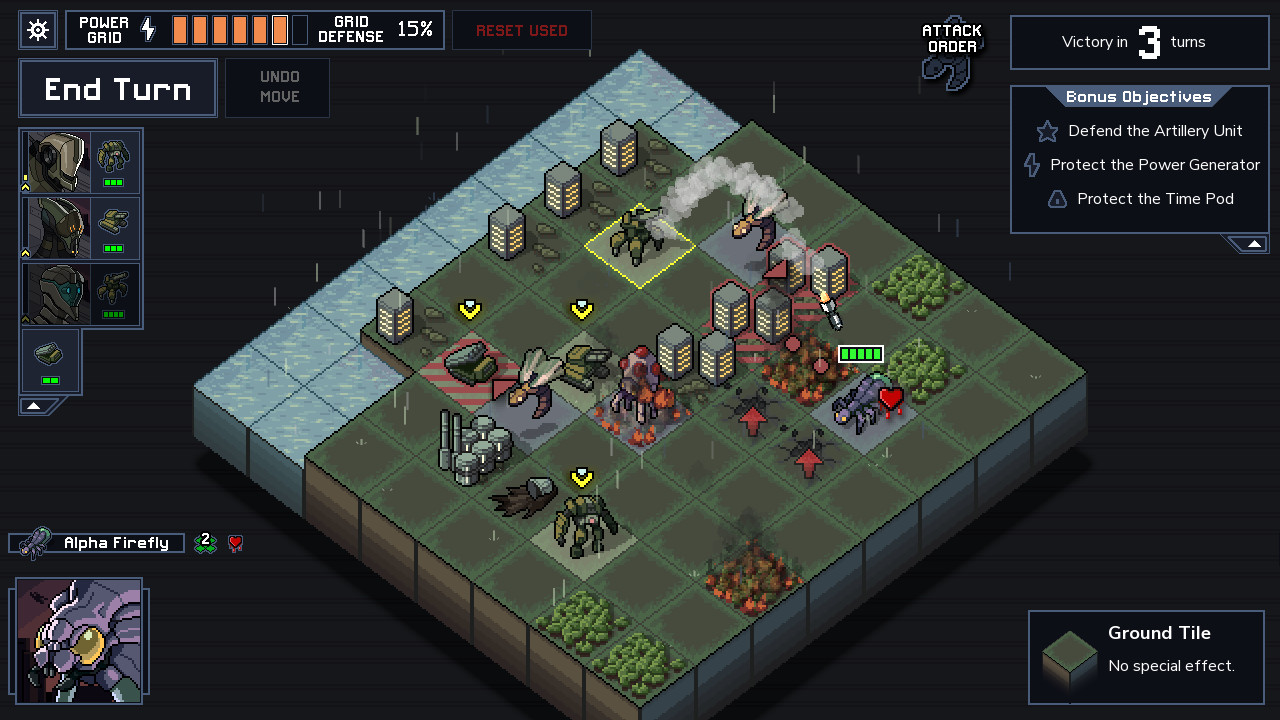
I never really clicked with FTL, the previous (and highly successful) game from Subset Games. Into the Breach, on the other hand, really worked for me. I’ve heard this game described as “kaiju chess”, and that’s a pretty good phrase. “Turn-based Pacific Rim” might be another good description. It looks like a tactical RPG, or possibly even a strategy game, but it’s much closer to a puzzle game, albeit a puzzle game that’s pretty open-ended in terms of how each puzzle can be solved. There’s not a lot going on visually in Into the Breach; every level is on an 8×8 grid, the animations are simple, the graphics are somewhat plain. But it’s got a masterful user interface that conveys exactly the right information in just a single screen, with all of the information you need to make decisions right in front of you.
It’s making, and then committing to, decisions that comprises most of the gameplay in Into the Breach. You can test out most of your actions before committing to them, and enemies always telegraph their next attack, so it’s a game about optimising a limited set of resources. The game is typically about spacial manipulation. While it’s certainly possible, and sometimes advantageous to deal direct damage to the enemies, more often than not you’re trying to use abilities that will move things around on the board in order to negate enemy attacks and cause them to destroy each other. The most interesting twist is that your goal isn’t to defeat all the enemies, nor is it to avoid death for your characters. Rather, you have to defend the civilian population by preventing the giant enemy insects from damaging buildings. Keep the enemies at bay for a few turns and they retreat, leaving the population safe.
6. Yakuza 6

For the longest time I thought the Yakuza games were just “Grand Theft Auto in Japan”, but having finally been convinced to give them a chance I now understand that that isn’t what they are at all. They’re not open-world crime simulators so much as they’re soap operas with a lot of punching. The Yakuza games are like if you took the old school beat ’em ups like Double Dragon or Ninja Turtles, gave them a fresh coat of paint, and threw a melodramatic (but effective) story of warring crime families on top. Another way I might describe them is to say that they’re like The Bouncer if it had actually been able to deliver on its promise of dynamic combat where you could use almost anything in the environment as a weapon.
Yakuza 6 is the latest in this series of games, and it tells the story of series protaganist Kazuma Kiryu, now getting older and tired, trying to leave the life of crime behind once and for all. The first few hours of the story barely even involve any fighting. The early going sees Kazuma trying to take care of a baby, which requires doing things like taking him on late night walks around town and playing a baby bouncing mini-game that helps calm the baby’s crying. It eventually escalates, of course, and in true Yakuza fashion it escalates to implausibly dramatic stakes. But it does something that far too few games do, which is taking time to establish its characters, setting, and stakes before kicking everything into high gear.
And I haven’t even gotten into how weird these games are. There’s an entirely optional real-time strategy game where you build up a gang to take on a rival gang that’s led by actual Japanese pro wrestlers. There’s another mini-game where you recruit people for a minor league baseball team that you manage. There’s a cat cafe that you can fill up with stray cats that you chase down on the streets of Kamurocho. It’s such a weird game. But a lot of fun.
5. Overcooked 2
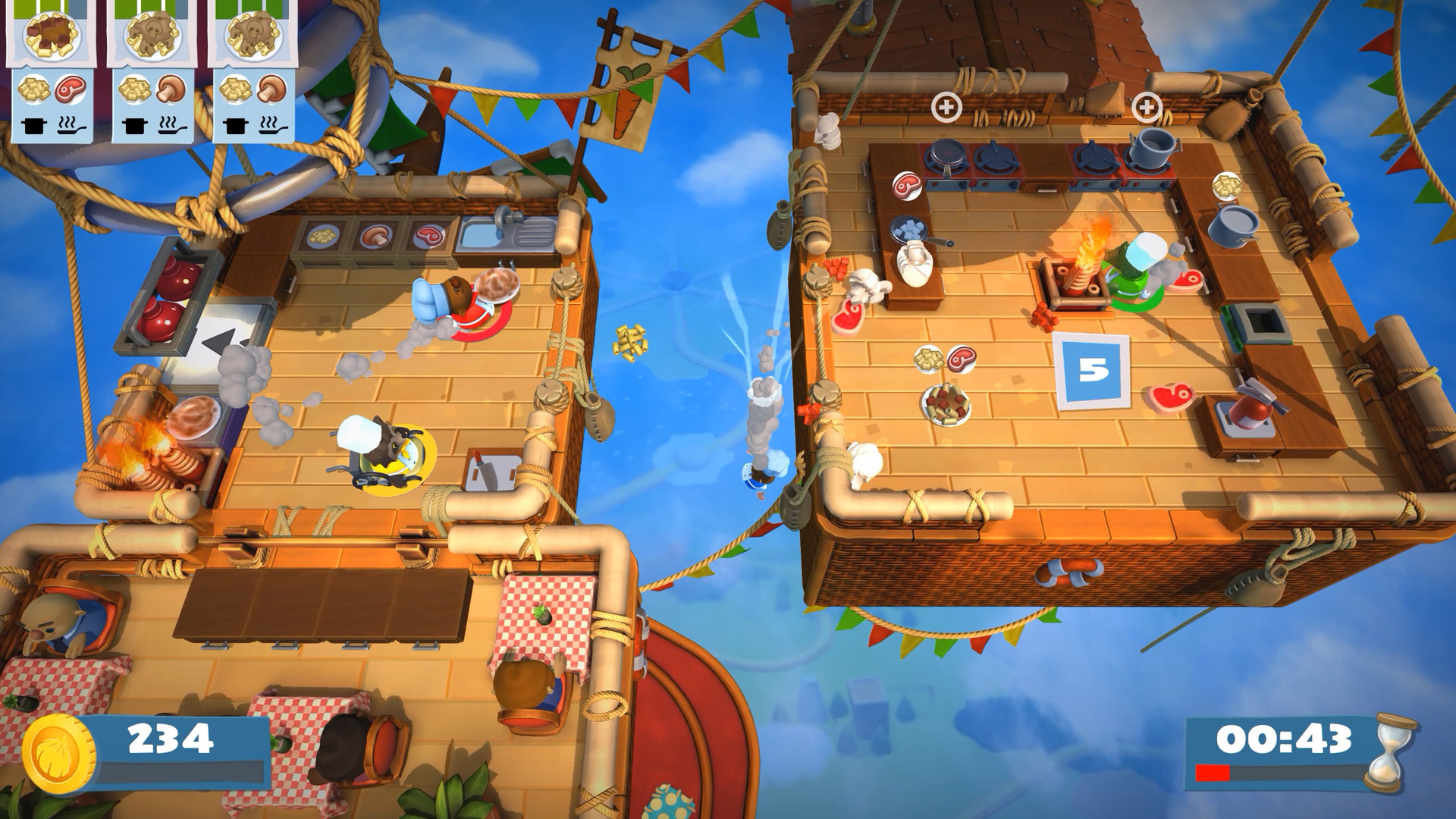
I had a ton of fun playing the first Overcooked, so I was happy to hear that there was a sequel coming out this year. Overcooked is a co-operative cooking game, but it’s so much more than that. It’s full of completely madcap humour, like mice who will steal cheese if you leave it out where they can reach it, or portals that you have to warp through to travel from one part of the kitchen to another. One level, seen in the screenshot above, has players split between two hot air balloons that rotate around each each. One side has all the ingredients, and the other side has all the stoves, so players have to co-ordinate to make sure they’re working effectively.
And that’s one of my favourite things about this game: it’s impossible to win without co-operating. It’s not a game where one player can get really good and do all the work while the other players are along for the ride. If everyone isn’t doing their bit, the recipes aren’t getting cooked. That could be frustrating if you’re in a group of people with short tempers, but in my experience it’s an absolute blast if you play with a good group. I highly recommend getting one or more friends together and giving this a go.
4. Subnautica
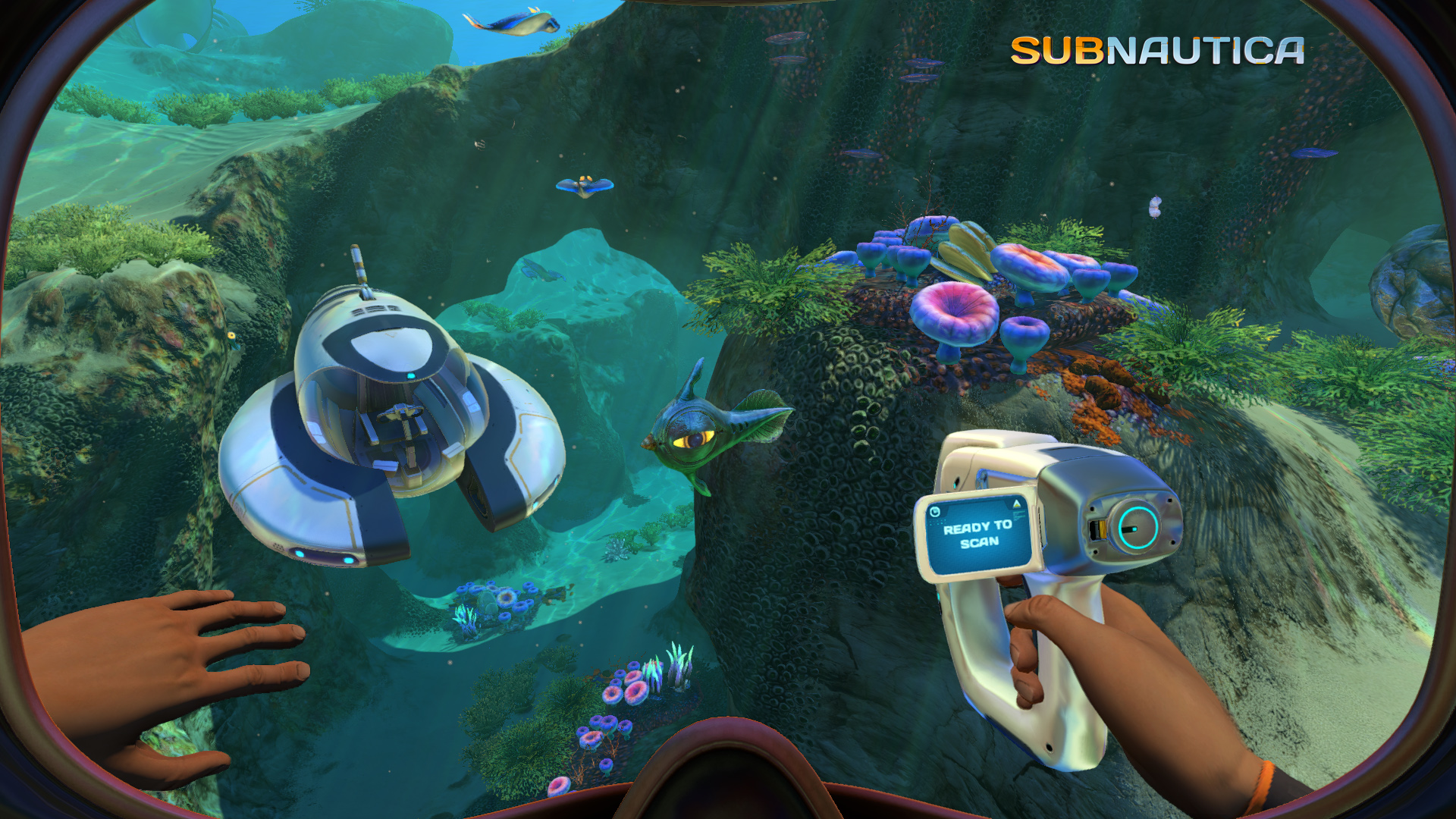
I am not especially into survival games, so I initially put off playing Subnautica under the impression that it was in the same vein as something like Day-Z or Ark (apparently this was the year of me correcting misapprehensions). While there are survival game elements in Subnautica, they’re not really what the game is about. In fact, it’s entirely possible to play the game with the food and water meters turned off, which is how I played it, and I found the experience much more enjoyable as a result. Subnautica‘s world is hand-crafted, not procedurally generated, and it tells a composed, linear story. It’s a game about exploration with a story carefully woven in, sort of like what No Man’s Sky became earlier this year.
There are still many of the trappings of survival games. There are resources to collect and items to craft. Crafting vehicles is particularly important, as each new vehicle that you craft enables you to travel to deeper and potentially more dangerous parts of the ocean. Crucially, though, this is a game almost entirely without combat. You’ll craft a knife early on, but it’s really designed for resource gathering and not for fighting. There are big, scary things deep in the ocean, but your only choice is to avoid them or flee. I don’t want to spoil anything about the story, but I will say that it’s well-written and does a good job of motivating the player to continue to build and explore. But most of all, Subnautica is a game about exploring a beautiful, terrifying ocean, and that’s an experience I’m completely on board with.
3. Hitman 2

Hitman 2 is everything the last Hitman game was, but more of it. Which is fine by me, since I think it’s a great format, with lots of room to explore. I’ll just quote from what I said last year about the previous game:
“[Hitman] creates a series of interlocking systems and open-ended quests that really reward you for exploring, experimenting, and understanding how the game world functions.
Each episode in Hitman tasks you with assassinating somewhere between one to four characters who are going about their day-to-day lives across the fairly large levels . . . Each episode features a large, complicated location like an Italian villa or a luxury hotel in Thailand, and they’re full of people doing fairly normal things on fairly normal schedules. Some of those people are clearly related to the central quest, like security guards in the hotel, while others are merely there to make the environments feel more alive, like shopkeepers in Sapienza.
The fun comes primarily from two things. The first is figuring out how to reach the target(s), since they’re never just wandering down an abandoned alley where you can assassinate them with ease. Usually this will involve some combination of sneaking as well as disguises – the best way to describe Hitman is as a ‘social stealth’ game where you’re trying to hide in plain sight. The second element that the game draws its fun from is the enormous variety of ways to interact with the world and characters. Each episode can be completed in a huge number of ways, and replaying the levels to try out different tactics is always a lot of fun. And once you’ve mastered each episode’s story campaign, there is a bunch of optional side content, like ‘elusive targets’ with their own mini-stories that you only get once chance to complete.
. . .
Hitman succeeds at setting up a toybox and letting the player create their own kind of havoc inside of it.”
2. The Banner Saga 3

The Banner Saga series has been some of my favourite role-playing games of the past decade. The first Banner Saga was my favourite game of 2014 was and the sequel was my favourite game of 2016. So it is a bit surprising, to me if no one else, that the final installment is not my favourite game of 2018. And there’s one reason for that – the ending. The Banner Saga 3 falls victim to the same fault as Mass Effect 3 (another RPG series I love that botched its ending) by introducing major new plot elements at the last moment and giving me an ending that felt like it undid the choices I’d made and the story I’d been telling through the rest of the series.
And that’s too bad, because the rest of The Banner Saga 3 is so good. Friends, it is so good. The unique tactical turn-based combat, with its clever trade-offs between armour and health, is more fun than it’s ever been. The story is well-written and full of emotionally resonant moments. The characters are well realised and many of them get fantastic scenes. There are truly difficult choices to be made, and the foreboding feeling of fleeing the apocalypse at the end of the world is palpable. The dual, intertwining stories work really well. But that ending, gah, that ending. So how do you rate a game that for 95% of its running time was the best thing you played all year and then ends on such a sour note? At #2, I suppose.
1. Monster Hunter World
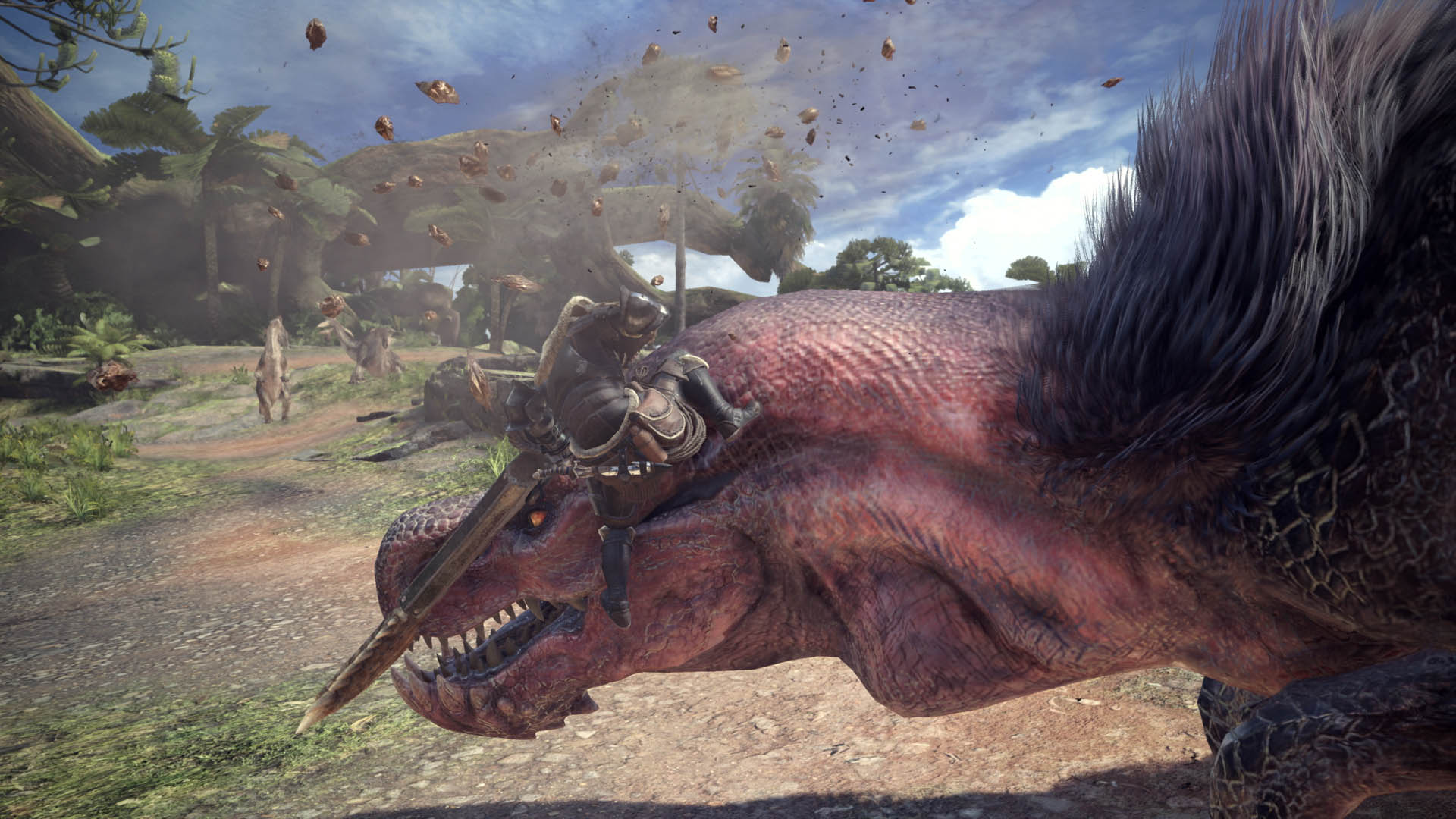
Monster Hunter World is a game where you swing huge swords at towering monsters and use the materials you collect in order to build ridiculous-looking armour and even more ridiculous weapons. Do you really need to know any more than that? Well, all right.
Monster Hunter World is a weird game, with a ton of interlocking systems, a lot to learn, and not a lot of help from the game to learn it. It must be said that MHW is an enormous improvement over previous Monster Hunter games in terms of approachability, with a massively improved interface and a lot of quality of life improvements that make playing it less annoying and more straight-forward. But it’s still a game that is pretty much unlike anything else out there, and it takes some time to figure out how it all works.
But once it starts to come together, oh is it a joy. “Most video games are too long” is a complaint I often make, but I’ve put dozens of hours into Monster Hunter World and I could easily have fun putting in a bunch more. There are 14 weapons to choose from, each of which has completely different controls and combos to master, and they’re a lot of fun. I’ve put in a decent amount of time learning four of them, and while I wouldn’t say I find them all equally satisfying, it’s been fun to figure out which ones work the best for me. Monster Hunter World has, unquestionably, the best combat system in any game I’ve played all year. The game is essentially just a long series of esaclating boss fights. Like Shadow of the Colossus if it was more of an RPG.
There’s so much more to say about why this is my favourite game this year that it’s hard to know where to start. The monster animations are incredible, maybe the best animation in any game I’ve ever played. They impart so much character and make the monsters feel so life-like. The environments and ecology in general are a real high point too, varied and gorgeous throughout. There’s the design of the armour sets themselves, which always kept me pushing to craft better and cooler gear. There’s the hilarious warrior cat companions. There’s the animation for the giant meals that get cooked before every quest you go on, which still make me laugh. There are rough edges in places, and it’s a game that requires patience to really understand, but there’s no filler. In a year when so many big budget games are full of stuff just to fill time, Monster Hunter World only ever wants to be one thing – Monster Hunter – and everything in the game contributes to making it the best Monster Hunter possible. It’s not like other games, but it is unmistakbly itself.

